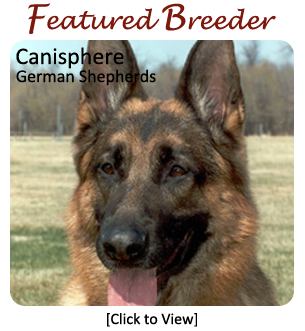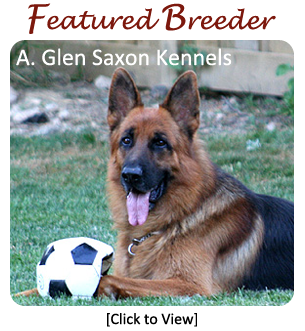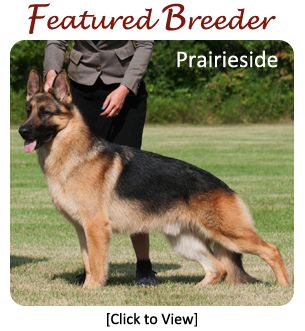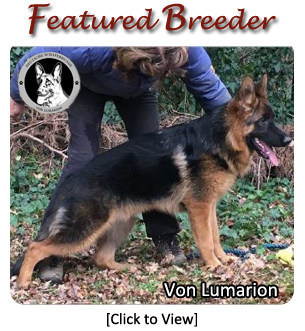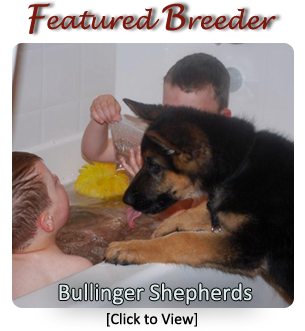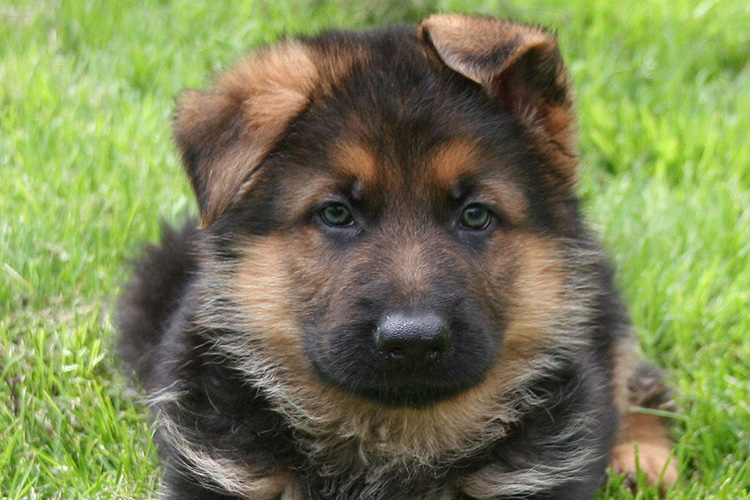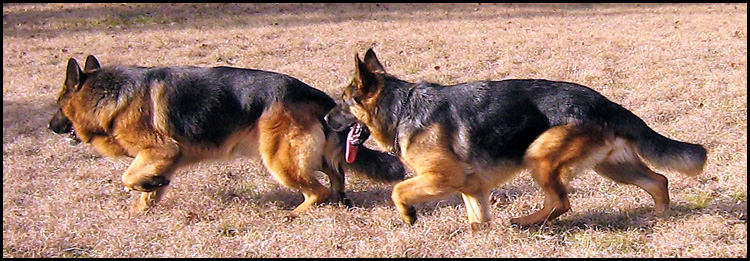
Origin: Germany
Height:
- – Males: Ideal height is 25in. (64cm) at the shoulder.
– Female: Ideal height is 23in. (58cm) at the shoulder.
– Variations of 1″ (3cm) above or below the ideal are acceptable.
Weight:
- – Male: Average between 75 and 85 lbs (34-39kg).
– Female: Average between 60 and 70 lbs (27-32kg).
Other Names: Deutscher Schäferhund; German Shepherd; GSD; Alsatian Shepherd; Alsatian
CLICK HERE to View Breeder Listings
Breed Profile
The name “German Shepherd Dog” is a literal translation from the German “Deutscher Schäferhund” but the breed is commonly referred to as simply the German Shepherd or GSD. In the United Kingdom, the breed was renamed to the “Alsatian Shepherd” or simply “Alsatian” after World War I, mainly due to anti-German sentiment and the fear that the original name would be a detriment to the breed. By 1930, the British Kennel Club authorised the German Shepherd name once again.
The German Shepherd is well known for his intelligence, traininability, devotion and loyalty. The breed is one of the most versatile; known as a family companion, Guide Dog, Police Dog, Search and Rescue Dog, Drug and Bomb Detection Dog, Herding Dog, and Tracking Dog to name a few. He is the working dog of choice for many and, in North America, is one of the most popular breeds — Ranked 2nd most registered breed by the Canadian Kennel Club and the American Kennel Club for 2015.
Physically, the German Shepherd gives an impression of strength, agility, and balance. He is considered to be a dog of mid-size, heavy enough to be effective as a herding dog or police dog, yet not so heavy as to be awkward. He should be well-muscled, alert and appear athletic and fit. There should also be a distinct difference in males and females whereby the dog is definitely masculine and the bitch, feminine.
The German Shepherd has a lustrous double coat with a varying amount of undercoat depending on the climate, season, and the amount of time the dog spends outdoors. The outercoat is dense, harsh, straight or may be slightly wavy, and lies close to the body. The coat colours come in a wide range but they should always be strong and rich without appearing washed-out.
The CKC and AKC Breed Standards fault a complete lack of undercoat, soft, silky or too long outercoat and a curly or open coat. In addition, both the CKC and AKC disqualify any white dog. The White German Shepherd Dog is still recognized and registered as a German Shepherd Dog under the AKC and CKC. However, because the colour white is a disqualification, they are not eligible to be shown in the conformation ring. The United Kennel Club (UKC) recognizes the White Shepherd as a separate breed and the Fédération Cynologique Internationale (F.C.I.) recognizes the breed as the “Berger Blanc Suisse.” For further information about the White Shepherd Dog, see The White Shepherd Dog.
A Brief History of the German Shepherd Dog
Captain Max von Stephanitz, known as the father of the German Shepherd Dog breed, used various old German herding and farm dog breeds as his foundation stock in the development of the breed. In 1899, he and Adolf Meyer, Ernst Von Otto and others formed the parent club for the breed — the Verein für Deutsche Schaferhunde (SV). A stud book was immediately started upon the founding of the club and the first dog to be registered was von Stephanitz’ dog, Hordand von Grafrath. Very strict guidelines were put into place for member breeders which included the control of which dogs could be used for breeding; which dog could be bred to whom; and before being bred, both the sire and dam had to have working titles plus at least a “G” (good) conformation rating. This very strict control by the Verein für Deutsche Schaferhunde (SV) helped the German Shepherd breed thrive and the club soon became the largest single-breed club in the world.
During the First World War, both German and French military were using German Shepherds as well as other breeds for various duties, including search and rescue of casualties; guarding the troops; and transporting ammunition, messages and first aid supplies between the trenches. Also during this war, many soldiers were blinded and the German authorities began training German Shepherds as “seeing eye” dogs as well. Today, the German Shepherd is still one of the most popular choices for guide dog work.
By the 1920s, Strongheart, who had been originally trained as a police dog in Germany and, even more famous, Rin Tin Tin, who was rescued as a puppy in France just before the end of World War I, had hit the big screen. As a result, the breed gained extreme popularity outside of Germany. Unfortunately, this led to irresponsible breeders who introduced poor breeding practices in an effort to cash in. Problems in temperament and health began to develop within the breed. By the end of the Second World War, the popularity of the breed had declined somewhat. However, not before genetic disorders and poor temperament issues became common in some bloodlines. Since that time, dedicated breeders have worked to restore the temperament and physical strength of the original German Shepherd.
— For a more detailed look at the history of the German Shepherd Dog breed see:
- The GSSCC – The German Shepherd
- The Nova Scotia German Shepherd Dog Club – Breed History — An outline of breed history from a North American perspective.
“I WILL LIVE AND DIE FOR YOU BECAUSE I AM A SHEPHERD!”
Health Issues
German Shepherd Dogs, as with other breeds, are susceptible to certain health problems, some of a genetic nature, others viral. If you are considering the adoption of a German Shepherd puppy, or any breed, it is very important to be selective in choosing a responsible and reputable breeder. Ensure that the prospective puppy’s parents have all health clearances. Breeding of any dog should not be done until after they have been proven to be free of evidence of significant hereditary diseases. (For more information on selecting a breeder, see the articles on the General Information page.)
Additional Health Resources:
- German Shepherd Dog Health Concerns
- The American German Shepherd Dog Charitable Foundation, Inc. — Devoted exclusively to funding research projects pertaining to the health of the German Shepherd Dog.
- AKC Canine Health Foundation
- Canine Health Information Center (CHIC) — German Shepherd Health Screening Recommendations — Providing a source of health information for owners, breeders, and scientists that will assist in breeding healthy dogs. CHIC is a centralized canine health database jointly sponsored by the AKC/Canine Health Foundation (AKC/CHF) and the Orthopedic Foundation for Animals (OFA).
- Health and Nutrition — Growing section of the Canada’s Guide to Dogs website which includes information on several health and nutrition related issues.
- OFA – Companion Animal Eye Registry (CAER)
- Orthopedic Foundation for Animals (OFA)
- Ontario Veterinary College (OVC)
- University of Pennsylvania Hip Improvement Program (PennHip)
- HealthGene — HealthGene Corporation is the leading provider of veterinary DNA diagnostic services in Canada.
- Labgenvet — Laboratory of Veterinary Genetics is a Canadian diagnostic laboratory that offers a comprehensive service of DNA tests for veterinary genetic diseases.
Breed Standards
- CKC Breed Standard
- AKC Breed Standard
- UKC Breed Standard
- The Kennel Club (U.K.) Breed Standard
- FCI Standard No. 166
- The German Shepherd Dog Illustrated Standard — From the German Shepherd Dog Club of America
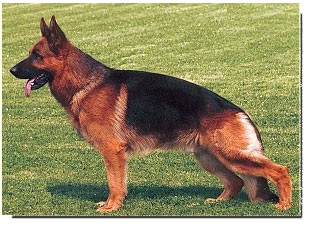
2X World Sieger VA1 Yasko vom Farbenspiel SchH lll KKL1
Photo courtesy of Canisphere German Shepherds
Did You Know?
- The German Shepherd is one of the most popular breeds in North America — For the past several years, the breed has been ranked 3rd most registered by the CKC and 2nd most registered by the AKC.
- Two movie-star German Shepherds, Rin-Tin-Tin and Strongheart, were largely responsible for the breed’s sharp rise in popularity after the first World War.
- In his book “The Intelligence of Dogs”, author Stanley Coren ranked the German Shepherd as the 3rd breed for intelligence (behind the Poodle and Border Collie).
Grooming Information
- Grooming — This section of the Canada’s Guide to Dogs website includes tips, articles and information covering all aspects of dog grooming along with a listing of Groomers from across Canada.
Training Resources
- RCMP Police Dog Service Training Centre
- Schutzhund — The German Shepherd Dog is the most common breed involved in the sport of Schutzhund. Schutzhund training concentrates on obedience work, tracking and protection. This section of the Canada’s Guide to Dogs website includes details on the sport as well as listings of Schutzhund clubs and associations.
- Training — For training information, see this growing section of the Canada’s Guide to Dogs website for tips, articles, as well as listings of training centres across Canada.
Additional Information
- The White Shepherd Dog — While the White German Shepherd Dog is registered as a German Shepherd Dog by the Canadian Kennel Club and the American Kennel Club, the colour white is a disqualifying fault for the breed and, therefore, white German Shepherds are not able to compete in the show ring. The United Kennel Club and the Fédération Cynologique Internationale now recognize the White German Shepherd as a separate and distinct breed.
- Before You Adopt a German Shepherd Puppy…Things You Need to Know
- What are the Benefits of Owning a Family Protection Dog? — If you’re considering getting a family protection dog to watch over the ones you love, CLICK HERE to read just some of the benefits you’ll experience.
- GSD Pedigree Database
- Is a Dog from the Herding Group Right for You?
- Herding Dogs — A developing section of the Canada’s Guide to Dogs website which includes training and general information about Herding/Stock Dogs; listing of Stock Dog Clubs and Associations; listing of upcoming shows and events; and more.
- Schutzhund — The German Shepherd Dog is the most common breed involved in the sport of Schutzhund. Schutzhund training concentrates on obedience work, tracking and protection. This section of the Canada’s Guide to Dogs website includes details on the sport as well as listings of Schutzhund clubs and associations.
- Clubs, Sports & Activities — For information on the many sports and activities you can get involved in with your dog.
- Working Dogs — The Working Dogs section of the Canada’s Guide to Dogs website provides information and listings of organizations that are involved in various dog jobs, such as Guide Dogs, Therapy Dogs, Police Dogs, Protection Dogs, and much more.
“Untiring, always zealous for duty, always attentive, always ready to serve, such is the character of our shepherd dog.”
— Captain Max von Stephanitz
Famous German Shepherds
Here are just a few of the countless German Shepherds who have become famous for one reason or another — From heroic acts to movie star celebrities, German Shepherds really do it all!
— Trakr the German Shepherd was named one of the most heroic dogs ever by Time Magazine for his efforts after the attacks at the World Trade Center and was credited with locating the last survivor found beneath the rubble. At the time, he was a retired Police Dog from Halifax, Nova Scotia. He and his trainer, Police Officer James Symington drove 15 hours to help in the recovery efforts. (Ref: Time Magazine)
Bruno
— A nine-month old German Shepherd named Bruno, from Newfoundland, was inducted into the Purina Animal Hall of Fame in 1996 for his heroic act of saving the life of 11 year old Donnie Skiffington after he was thrown from his bicycle and landed in a ditch. While the boy lay unconscious and bleeding, Bruno licked Donnie’s face until he regained consciousness. He then began to pull him by the shirt collar towards home.
Tracker
— Tracker, a ten-year-old German Shepherd from Sudbury, Ontario, owned by Sergeant Larry Bigley, was the inspiration behind the “Service Dog of the Year” Award. During the seven years that Tracker served in the Sudbury District, he was involved in about 500 searches for missing persons, criminals, drugs and security details.
Appollo
— In March 2002, Appollo, a NYPD German Shepherd was awarded the Dickin Medal* on behalf of all the search and rescue dogs who participated in the rescue operations at the World Trade Center site and the Pentagon following the September 11th attacks. The citation for the award is as follows:
“For tireless courage in the service of humanity during the search and rescue operations in New York and Washington on and after 11 September 2001. Faithful to words of command and undaunted by the task, the dogs’ work and unstinting devotion to duty stand as a testament to those lost or injured.”
Appollo also received the AKC Humane Fund Award for Canine Excellence (ACE) in 2001 and was honoured for his work at the Westminster Kennel Club Dog Show in 2002 in which he and several other dogs from the NYPD’s K-9 unit participated.
* — “The PDSA Dickin Medal is the highest award any animal can receive whilst serving in military conflict. It is recognised worldwide as the animals’ Victoria Cross. Instituted in 1943 by PDSA’s founder Maria Dickin CBE, it acknowledges outstanding acts of bravery or devotion to duty displayed by animals serving with the Armed Forces or Civil Defence units in any theatre of war throughout the world.” — For more information on the Dickin Medal, see www.pdsa.org.uk
— Nellie, a six year old German Shepherd from Vienna, Ontario travelled three kilometers back to her home to get help for 78 year old Ken Emerson, who lay injured after his tractor had overturned and crushed his pelvis. When Nellie arrived home, Mrs. Emerson noticed a strip of her husband’s shirt was wrapped around the dog’s collar as a message and so she immediately sent for help. Nellie was inducted into the Purina Animal Hall of Fame for her heroic act in 1994.
Ty
— In 2015, K-9 Ty Ty Road RN CGC, an eight-year-old German Shepherd handled by Melissa Frye of Southport, Florida, earned the AKC Humane Fund Award for Canine Excellence (ACE) for his heroic work as a Search and Rescue Dog. Ty is cross-trained in human remains detection as well as live find search and disaster work. Over the course of his six year career, Ty was the go to dog in his department for recovery searches and helped bring closure to families that have lost loved ones. He was deployed in over 60 missions with great success.
Bullet
— Bullet was a German Shepherd Dog owned by Roy Rogers. Not only was he a family companion but he also starred as himself in the “Roy Rogers Show” and was featured in more than 100 movies.
Rin Tin Tin
— Rin Tin Tin and his descendants have delighted and entertained worldwide audiences for over 80 years. Rin Tin Tin is still one of the most famous and recognized names in German Shepherd Dog history.
Strongheart
— Etzel von Oeringen, or better known as Strongheart, was the first German Shepherd to appear in motion pictures. He appeared in several movies, including a 1925 adaptation of White Fang. He has a star on the Hollywood Walk of Fame.
The Littlest Hobo
— The Littlest Hobo, starring a dog named London, was originally created by Dorrell McGowen for a television movie in 1958. Following the huge success of the movie, a television series was filmed in black and white between 1963 and 1965, with a total of 65 episodes. The series was remade in 1979 and became a familly favorite for many years. Although several dogs were used over the years to play the part of London, all were very well trained German Shepherds.
*NOTE 1: CHIC – The Canine Health Information Center “is a database of consolidated health screening results from multiple sources. Co-sponsored by the Orthopedic Foundation for Animals (OFA) and the American Kennel Club (AKC) Canine Health Foundation, CHIC works with parent clubs to identify health screening protocols appropriate for individual breeds. Dogs tested in accordance with the parent club established requirements, that have their results registered and made available in the public domain are issued CHIC numbers.” To learn more, visit: www.caninehealthinfo.org
*NOTE 2: The Fédération Cynologique International (FCI) is the World Canine Organization, which includes 91 members and contract partners (one member per country) that each issue their own pedigrees and train their own judges. The FCI recognizes 344 breeds, with each being the “property” of a specific country. The “owner” countries write the standards of these breeds in co-operation with the Standards and Scientific Commissions of the FCI, and the translation and updating are carried out by the FCI. The FCI is not a breed registry nor does it issue pedigrees.
Breed Listing
Quick Links
Get In Touch
- Email: canadasguidetodogs@gmail.com
- Email: info@canadasguidetodogs.com
- Visit us on Facebook: www.facebook.com/CanadasGuideToDogs
— CanadasGuideToDogs.com is an Amazon Associate as well as a participant in various affiliate programs, as such fees are earned from qualifying purchases.

